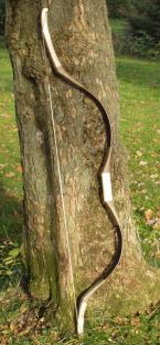Composite Bow
Explain how Europe benefited from cultural diffusion during the period c. A.D. 1000 - 1500.
The composite bow is composed of several different materials glued together, hence it is a composite
construct.
Unlike solid wood bows, composite bows could have varied materials such as bark, sinew, bone, wood, horn, metal, and glues.
This composite construction gave bows more power, allowed for more uniform construction and was more reliable than simple
wood bows. Ancient simple wood bows could vary in strength and quality depending upon the material used, the characteristics
of the individual tree, and many other variables. Composite bows eliminated most of those factors.
The composite bow is believed to have appeared in the hands of Assyrian archers as early as 1800 BCE, though archeological finds place its widespread use throughout the Middle East by the 13th century B.C. Assyrians warred with the Egyptians, Babylonians, and other civilizations and used the power of the composite bows to make a significant impression on their rivals. Within a few years Egypt, Babylon and Hittite civilizations had their own version of the composite bow.
Typical composite bows are constructed of a wood core with a horn layer on the interior portion of the bow's curve and sinew on the exterior. Horn allowed for compression while sinew acted like a spring and caused the bow to spring back into shape with more force. These layers were glued upon one another and compressed, shaped into a bow shape and allowed to cure for several weeks.

Composite Bow.
The most famous use of composite bows was by the Mongol invaders. The Mongols added an important advance to their
bows as well. They made the bow a recurve. The recurve bow follows the basic D
shape of a regular bow, but the upper
and lower ends curve back out toward the front of the bow. This allowed for a more compact weapon and more powerful
delivery of arrows, which was important since Mongols also paired their composite bows with speed by firing while
mounted and moving. The recurve composite bow was a main tool in forging the largest land empire the world has ever known.

Muslim Archer using a Composite Recurve Bow with an arrow guide. c. 1100 A.D.
During the Crusades, the composite recurve bows of the Mongols had been adapted by Turkish and other Muslim warriors who used them to great effect in the second and subsequent Crusades, defending and re-taking cities all throughout the Crusader Kingdoms of the eastern Mediterranean. By the 11th century, the techniques used to create composite bows were being adapted to another bow technology - the crossbow.
Modern bows are almost always composite bows made out of synthetic materials such as fiberglass, metal and carbon fibers. This allows for a more controlled and consistent product as well as offering substantially more power than simple wood bows.
